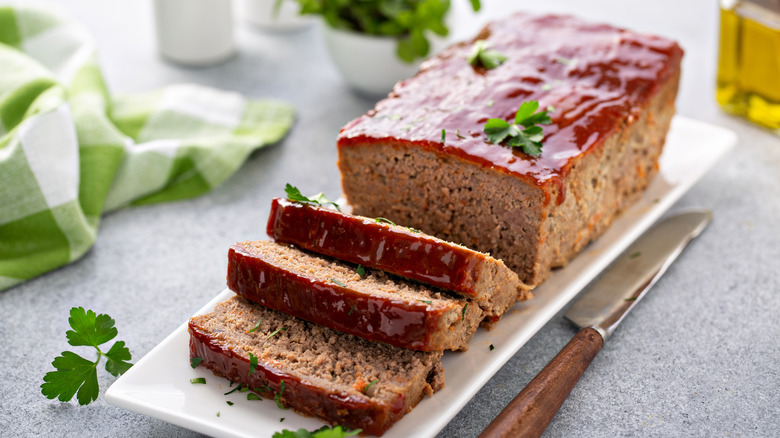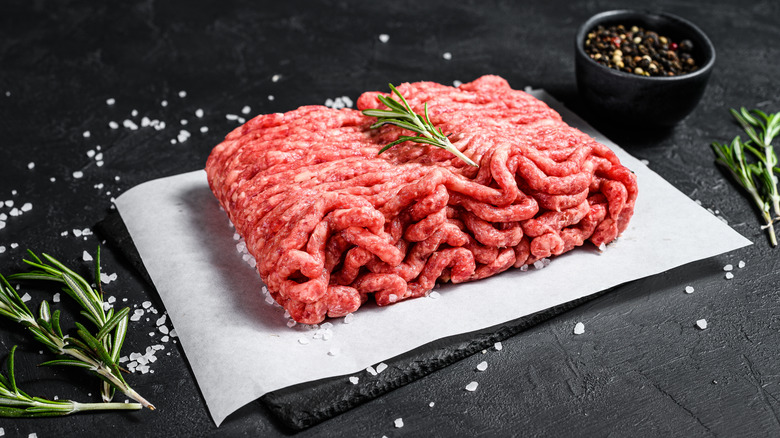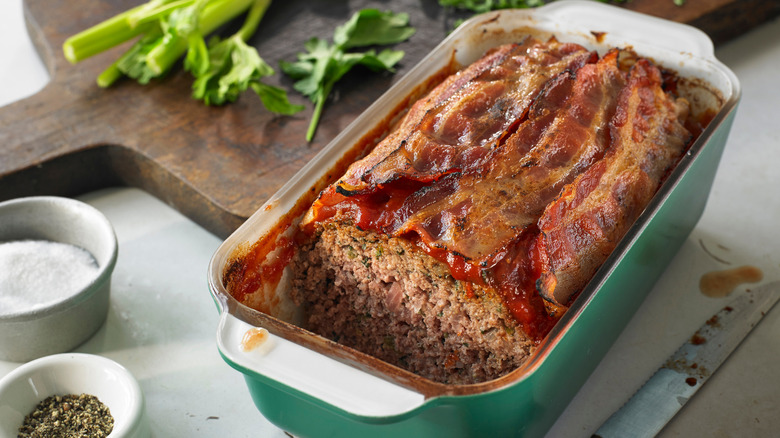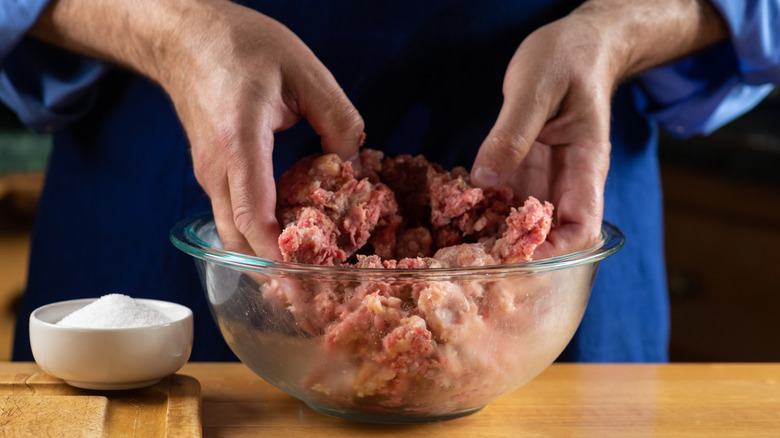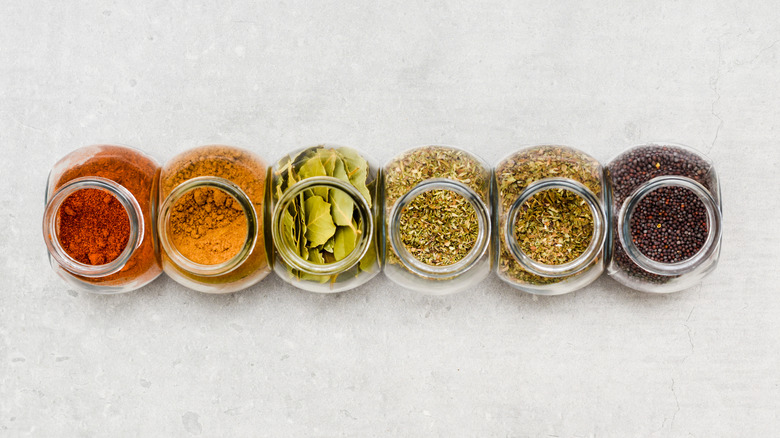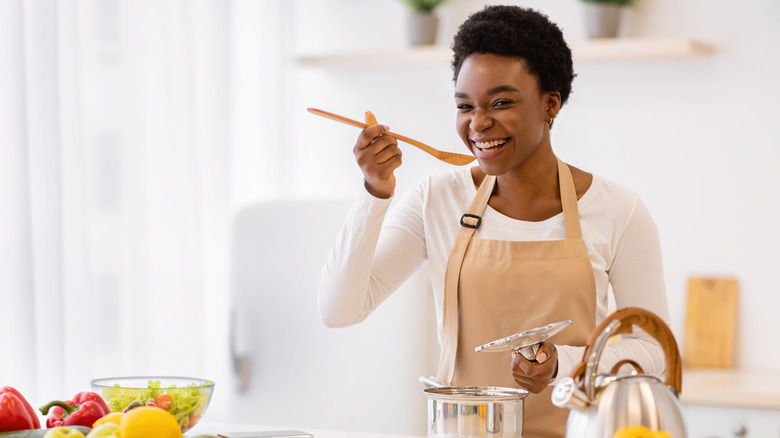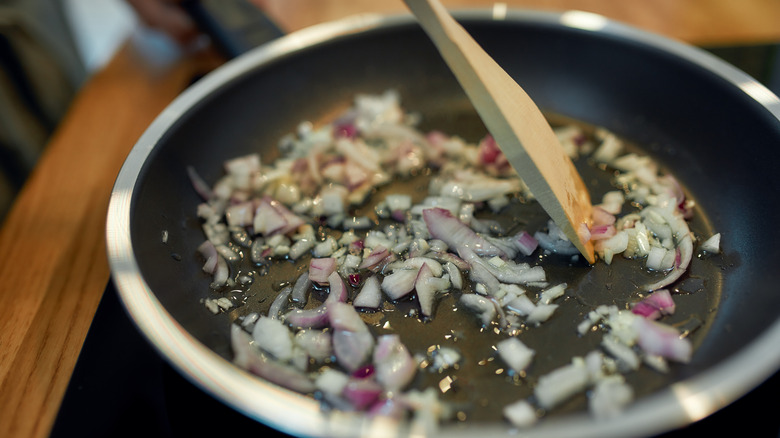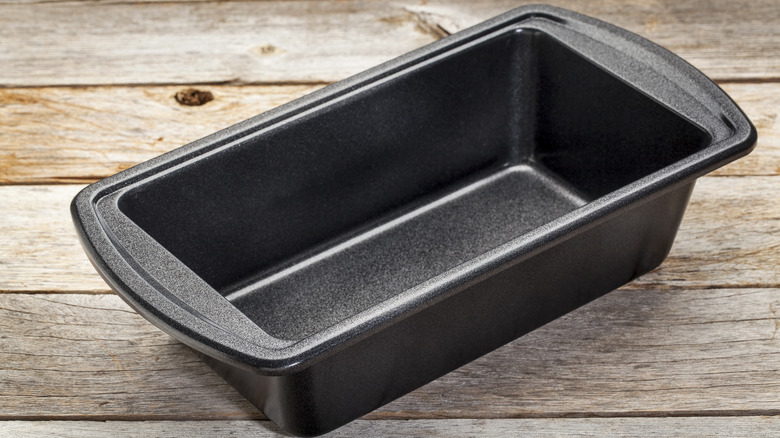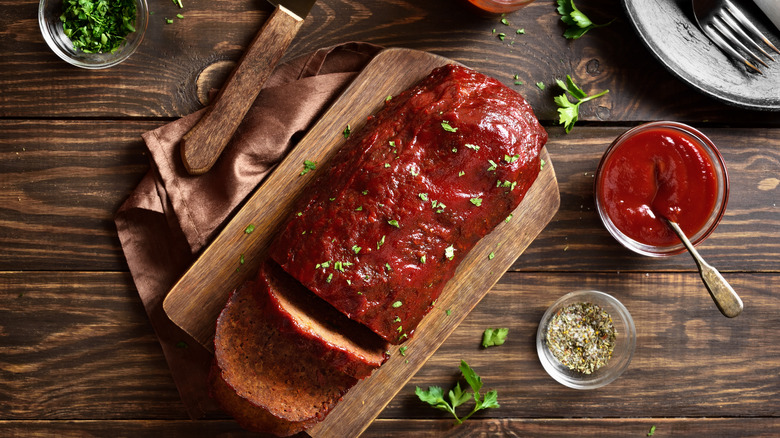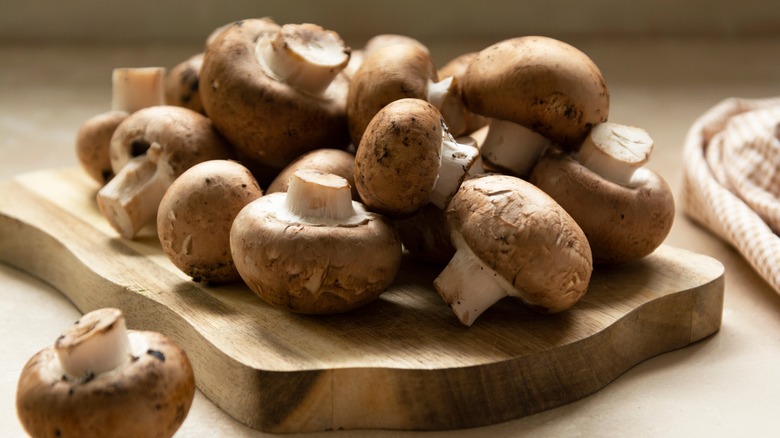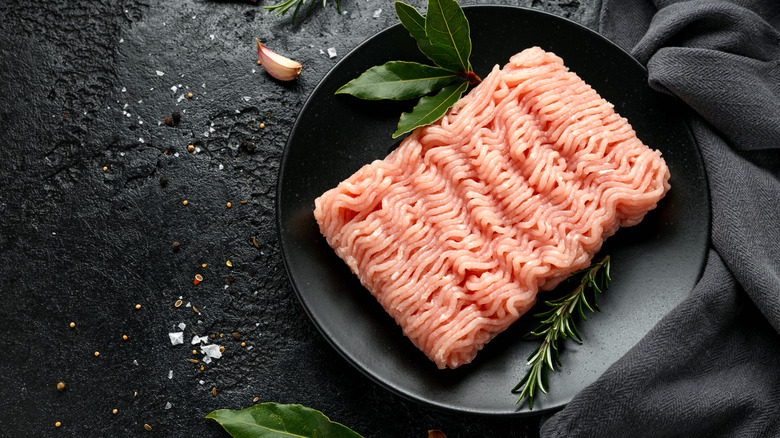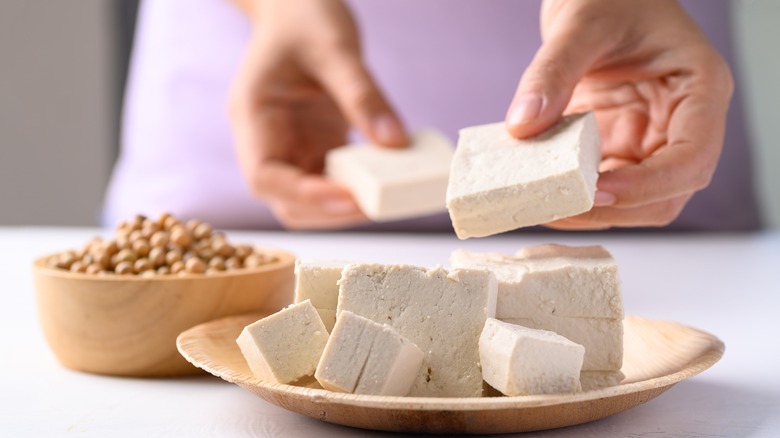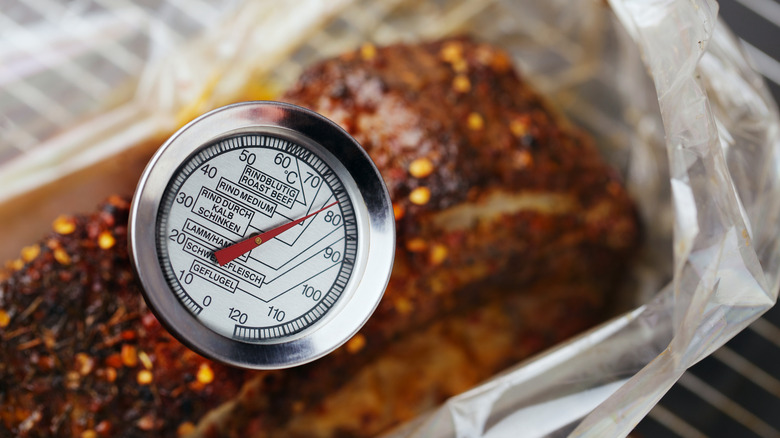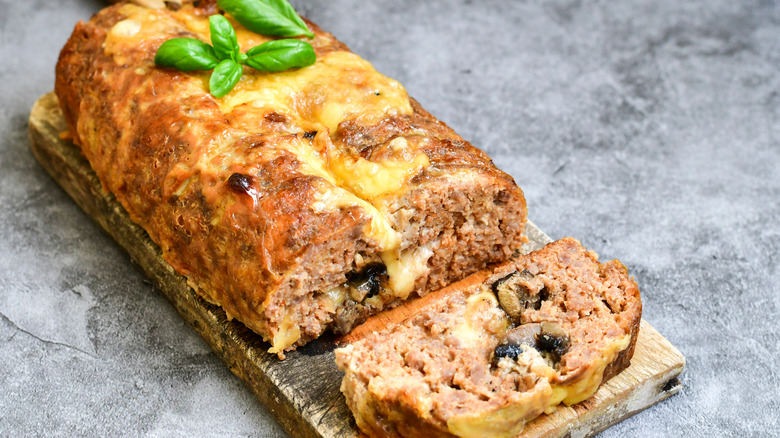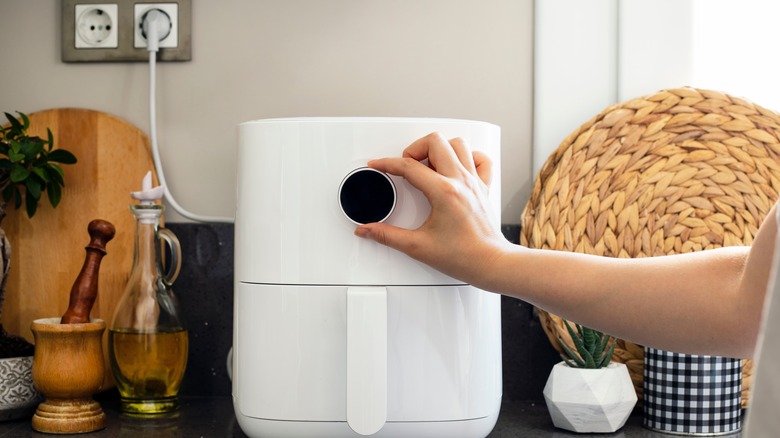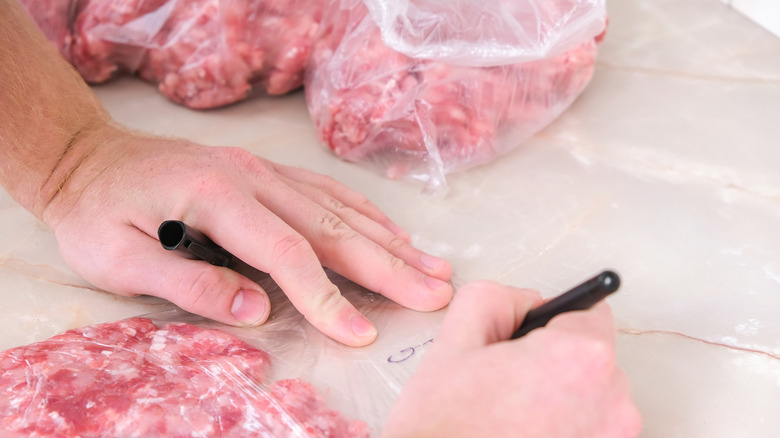16 Meatloaf Mistakes You're Probably Making
Classic beef meatloaf is a dish that has a lot of potential. However, it is also one of those meals that many people don't like — or at least think they don't like. This negative opinion towards meatloaf, however, may not be justified. While it is a relatively easy dish to prepare, people make some common mistakes when cooking it. These mistakes can have a negative impact on how the recipe turns out, leaving you, or others that you cook for, thinking that meatloaf is not a very tasty dish.
Even if you enjoy meatloaf, you may still make some of these common mistakes. Making a few changes to your approach the next time you prepare it could result in a juicier and even more delicious meal to share with others. Whether meatloaf is your go-to Sunday night dinner or something you rarely prepare because no one in your house seems to like it, read on to identify some common mistakes that you'll want to avoid making the next time meatloaf is on the menu.
1. Not using a fatty enough meat
There are certain recipes where it is a good idea to choose leaner meats. However, meatloaf isn't one of them. Ground beef and other meats are labeled to identify how much lean meat and fat they have. You may see labels such as 70/30 (70% lean beef and 30% fat), 80/20 (80% lean beef and 20% fat), or 90/10 (90% lean beef and 10% fat) on a pack of ground beef at the grocery store. When making meatloaf, 80/20 ground beef is ideal.
You need some fat to ensure the meatloaf doesn't get dried out. Moreover, a bit of fat will help give the meat a better flavor and keep it from falling apart. You could also try a 70/30 pack of ground beef for your next meatloaf, but you might find it to be a bit too greasy. 90/10 ground beef, while healthier, just isn't a suitable option for meatloaf. It isn't fatty enough to impart a delicious flavor and keep the meat from getting too dried out as it cooks.
2. Not allowing the meatloaf to rest after cooking
Another mistake many cooks make when preparing meatloaf is not giving it a few minutes to rest before cutting and serving it. We get it — you just spent a lot of time preparing the meatloaf and waiting for it to cook, and now you and everyone else in the house are hungry and ready to eat. Well, cutting into the meatloaf immediately after removing it from the oven is going to backfire and negatively impact the finished dish.
Giving the meatloaf about 15 minutes to rest before you slice into it is ideal. This will give everything time to cool down slightly and for the meat to absorb more of the juices. If you cut it right away, it is more likely that juices will just run out of the meat when you remove a slice from the loaf. This can leave the piece more dry and crumbly than you'll want.
3. Not making a panade for your meatloaf
If you're not making a panade, your meatloaf isn't living up to its full potential. If you don't even know what a panade is, don't worry, you're not alone. A panade is a mixture made by combining a liquid and a starch. Adding it to recipes, such as meatloaf, meatballs, and even hamburgers helps keep the meat tender and delicious. Even if the meatloaf recipe you're making calls for only breadcrumbs, you should still consider adding a panade — or look for an alternative recipe that uses one.
To make a panade for your meatloaf, you'll need just two ingredients: starch and liquid. A panade for a meatloaf is typically made using breadcrumbs and milk. However, there are other starch and liquid options to consider. Some other starches include crackers, cooked rice, bread, or cooked potatoes. Liquid options include buttermilk, broth, water, cream, and yogurt. Follow the ¼ cup starch and ¼ cup liquid ratio for each pound of ground meat. You'll be glad you did when you cut into the tender and juicy meatloaf.
4. Overmixing the meatloaf ingredients
If you've ever made a meatloaf and stirred after adding each ingredient, you've been making a mistake. If you overmix the elements together, you will end up with a tougher meatloaf. The finished product is also likely to be dense rather than light and airy, as meatloaf should be.
Rather than stirring after adding each ingredient or overworking the mixture, be purposeful when mixing. Add the meat to a bowl and top it with all the other ingredients. Ready to grab a spoon or blender? Stop. Instead of using a small appliance or even a spoon to mix the ingredients together, use your hands. You'll be in greater control of ensuring everything gets incorporated together without risking overbeating anything to make the meatloaf turn out too tough or dense. Stop mixing immediately after the ingredients are well distributed. They do not have to be packed tightly together to add to the pan for baking.
5. Not seasoning the meat
When you make a meatloaf, what seasonings do you add to the beef? If you answered that question by saying, "nothing" or "salt and pepper," you've just discovered another mistake you've been making. Adding some salt and pepper to the meatloaf is important, but it is not sufficient. If you stop with just salt and pepper or, even worse, don't add anything, the meatloaf will turn out bland.
As for what seasonings you should add, that is up to you. Aim for at least adding some garlic powder and onion powder because they will help ensure the meatloaf browns properly as it cooks. Depending on your taste preferences and what you'll be serving alongside the meatloaf, you can consider adding other seasonings, including oregano, rosemary, dried mustard, paprika, thyme, and basil. You can also find meatloaf seasoning packets in the grocery store, though you may find that you like being in control over how much of each spice you add.
6. Not tasting the mixture before baking it
Adding seasonings to meatloaf is really just a guessing game, isn't it? How are you supposed to know if you added enough garlic powder, basil, or any of the other spices you selected? Well, you have to taste it, of course. If you're worried that we're asking you to consume raw meat, we're not — that would be a huge mistake that could make you sick. So, make sure your meat is cooked to a minimum internal temperature of 145 degrees Fahrenheit.
Rather, you can take a small scoop of your meatloaf mixture out and brown it up in a sauté pan. Give the meat enough time to cook through, then do a quick taste test. If everything tastes good, you're ready to bake the meatloaf. If you think it is a bit too bland, try adding the seasonings that you felt were lacking after the taste test. Taking this extra step will add a little bit of time to the cooking process, along with a few more dishes, but it is well worth it for the confidence it will give you that your meatloaf will taste great when it comes out of the oven.
7. Not sautéing vegetables before adding to the ground meat
If you're looking to make a heartier and more filling meatloaf, adding some vegetables to the mix is a great way to accomplish that goal. However, don't simply toss the raw veggies in with the mixture. Sure, they'll cook partially in the oven as the meatloaf cooks, but they will still end up somewhat hard, with a raw taste and texture, when the meatloaf is finished.
Take a few minutes to pre-cook the vegetables before you add them to the meatloaf mixture. This will help ensure they are soft and don't give the meatloaf an undesired crunchy texture. The best way to pre-cook most vegetables before adding them to meatloaf is to sauté them in some melted butter. They'll soften up nicely, which will enable them to release moisture as the meatloaf cooks, helping to prevent it from getting dried out.
8. Not choosing the right pan or skipping it altogether
Proper pan selection is essential when making meatloaf. The pan you choose needs to be large enough to leave space for the edges of the meatloaf to breathe as they cook. Avoid picking a pan that will only hold the entire mixture if you pack it down hard and tight. Doing so will result in a very dense meatloaf, which will be far less enjoyable than one that is tender and airy.
Another option to consider is to completely skip the pan altogether. Rather than using a loaf pan or baking dish with tall sides, consider using your hands to shape the meat mixture into a loaf-like shape and baking it on a sheet pan. This will leave the edges with more than enough space to breathe, allowing them to get nice and caramelized. If you're going to try this approach, remember to be careful not to overwork the mixture trying to form the loaf. You don't want to inadvertently end up making it turn out too tough or dry.
9. Not adding a glaze to the meatloaf
If you haven't already been making a glaze to go with your meatloaf, you might want to change that. There are several reasons to consider adding a glaze to your favorite meatloaf recipe. First, they can enhance the flavor of the meatloaf and really bring it up a notch. Even some people who don't like meatloaf will find it to be quite tasty with the right glaze recipe. However, possibly even more important than its benefit to the overall flavor profile, a glaze will also help ensure that your meatloaf turns out moist. With the glaze on as the meatloaf bakes, less moisture will escape from the meat, making the finished product all the more enjoyable.
If you've never made a glaze for a meatloaf before, don't worry. It's actually pretty simple, and most recipes only call for a few ingredients. Many traditional glaze recipes use either ketchup, barbecue sauce, or a little of both. Then, you'll add a little vinegar and some brown sugar to make it a bit sweet. However, this isn't the only recipe you can use. You can also try coming up with your own combination of ingredients to deliver the exact flavor you're looking for.
10. Overlooking mushrooms as a low-carb binding alternative
If you've been trying to follow a paleo, keto, Atkins, or any other low-carb diet, you may have assumed you'd have to completely cut meatloaf out of your recipe rotation. With the breadcrumbs in the recipe, it doesn't exactly sound like a low-carb-friendly option. Fortunately, there are ways that you can make meatloaf without using breadcrumbs. The breadcrumbs in a meatloaf recipe serve as a binder. That means that they help keep the meat together and moist.
So, if you're looking for a low-carb-friendly option, you will have to use something else that will also serve to bind the different ingredients together. Mushrooms can make the perfect low-carb binder. Not only will they help keep your loaf from falling apart, but they'll also contribute to the overall taste of the meatloaf. When using mushrooms as a binder, you'll want to use finely chopped ones. You can sauté them in some ghee, butter, or another cooking fat of your choice. Add the soft cooked mushrooms with the rest of your ingredients and work together to form the meatloaf.
11. Not considering other types of ground meat
Ground beef can make a moist and delicious meatloaf, but it is far from the only option to consider for this meal. If you've only been using ground beef to make your meatloaves, maybe it is time to explore some of the other possibilities out there to see how different meats impart different flavors to this classic meal. You can make meatloaf using pretty much any type of ground meat.
Some of the different options that you might want to try to include ground turkey, ground chicken, or ground bison. If you're working with a leaner cut of meat, just remember that you may need to add some additional fat to the recipe. Fattier ground beef helps keep a meatloaf moist and prevents it from falling apart as easily. A simple fix for this when working with other types of meat that are not as fatty is to add a little bit of cheese. Cheese is fatty and will help make sure everything tastes amazing.
12. Not trying a vegetarian meatloaf
Just as you can stray from the traditional ground beef to try different types of meat when making a meatloaf, you can also stray away from meat altogether. Yes, it is called meatloaf, but you can also make a very delicious vegetarian option. There are several vegetarian substitutes that you can try in place of ground beef. A few of these include tofu, lentils, tempeh, and beans. There are also several meatless options at the grocery store, such as Beyond Meat or Match Meat.
When choosing one of the ground beef substitutes mentioned above, you'll want to use the same amount of the substitutes as what is called for in the recipe. Because these vegetarian options are also lower in fat, you may want to add some cheese or another fattier substitute to help ensure that everything stays together nicely and remains moist. Finally, keep in mind that a vegetarian meatloaf will likely cook more quickly than a traditional ground beef one. Keep track of the cooking process and adjust the time as necessary.
13. Overcooking the meatloaf
We've already talked so much about ways to avoid making meatloaf dry — from choosing a fatty enough meat to glazing the meatloaf before baking and choosing the right pan. However, there is one more thing that you'll want to avoid doing to make sure that your meatloaf doesn't come out too dry. You don't want to overcook the meatloaf. All ovens vary, so even if you are following a recipe very carefully, your oven could end up cooking the meatloaf slightly faster than the one used to test the recipe. Similarly, if your meatloaf is not as tall or dense as the one from the original recipe, it may also take less time to cook.
To avoid the problem of overcooking your meatloaf and ending up disappointed that it is too dry, use a digital thermometer to monitor the internal temperature. A beef meatloaf should reach an internal temperature of 160 degrees Fahrenheit to be considered done. However, one of the biggest mistakes people make is removing their meatloaf from the oven once the temperature is already at 160 degrees Fahrenheit. The meat will continue cooking for a few minutes right after coming out of the oven, meaning it will end up at a higher temperature than you originally expected. To avoid this mistake, take the meatloaf out of the oven once it is at about 155 degrees Fahrenheit and let it rest and continue cooking for a few additional minutes.
14. Not trying a cheese-stuffed meatloaf recipe
If you've been searching for a way to liven up your meatloaf recipe or make it more appealing to some of the pickier eaters in your household, you should really try making a cheese-stuffed meatloaf. Adding cheese can make nearly anything better, and the same is certainly true for meatloaf. Making a cheese-stuffed meatloaf is easier than you may think.
To start, You can mix up a batch of your favorite meatloaf recipe. But instead of adding it all to the loaf pan, only add about half to the bottom of the pan. Then, add some mozzarella cheese, cheddar cheese, or whatever type of cheese you enjoy over the bottom layer of meatloaf. Add the rest of the meatloaf mix, and bake until it reaches 155 degrees Fahrenheit. When you slice into the meatloaf to find the gooey cheese, your mouth is bound to start watering.
15. Not considering alternatives to an oven
If you think a meatloaf can only be made in the oven, think again. Whether your oven is broken, you don't want to turn it on and heat up the house, or you simply want to experiment with some of your favorite small kitchen appliances, you can try a new meatloaf recipe. The next time you want to make meatloaf, consider using your Instant Pot.
There are many benefits to cooking meatloaf in the Instant Pot. First, you can avoid wasting all the energy needed to heat up the oven. Second, the meatloaf will cook faster in the Instant Pot — about 25 to 30 minutes. This can help you get dinner on the table faster on a busy night.
If you have an air fryer, you can also use it to make meatloaf. Cooking meatloaf in the air fryer takes about the same amount of time as the Instant Pot. It can also be a lifesaver after a long day at work or school when you just want to cook dinner quickly.
16. Not making a double (or triple) batch to freeze
Whether you eat meatloaf weekly or only cook it once every few months, you could save a lot of time and effort by making a double or triple batch each time. This way, you can have one meal right away and put one or two more in the freezer for a later date. You really won't be adding that much more work for yourself since you'll already have all the ingredients out. And you'll certainly take much less time to double the recipe than you would to make it entirely from scratch the next time you want to serve meatloaf for dinner.
When freezing meatloaf, you have the option to freeze the mixture raw or freeze the fully-cooked loaves. If you want to really cut down on your time for future dinners, freezing it fully cooked might be the right choice. If you have the time, you might prefer to freeze the meatloaf mixture raw so that you can cook it right before you plan to serve it. This will likely result in an improved texture.
To freeze raw meatloaf mix, form it into a loaf and wrap it with one or two layers of plastic wrap. Then, place the loaf in a freezer bag. Seal the bag securely and write the date on it before putting it in the freezer. The same can be done if you want to freeze already-cooked meatloaf — just make sure it has been given time to cool down after baking. Remove the meatloaf and thaw it in the refrigerator for about 24 hours before you plan to cook it.
